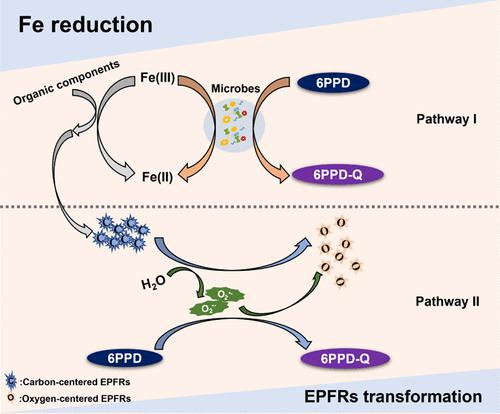当前位置:
X-MOL 学术
›
Environ. Sci. Technol.
›
论文详情
Our official English website, www.x-mol.net, welcomes your
feedback! (Note: you will need to create a separate account there.)
Enhanced Formation of 6PPD-Q during the Aging of Tire Wear Particles in Anaerobic Flooded Soils: The Role of Iron Reduction and Environmentally Persistent Free Radicals
Environmental Science & Technology ( IF 10.8 ) Pub Date : 2023-03-29 , DOI: 10.1021/acs.est.2c08672 Qiao Xu 1, 2 , Gang Li 1, 2 , Li Fang 3 , Qian Sun 4 , Ruixia Han 1, 2 , Zhe Zhu 5 , Yong-Guan Zhu 1, 2
Environmental Science & Technology ( IF 10.8 ) Pub Date : 2023-03-29 , DOI: 10.1021/acs.est.2c08672 Qiao Xu 1, 2 , Gang Li 1, 2 , Li Fang 3 , Qian Sun 4 , Ruixia Han 1, 2 , Zhe Zhu 5 , Yong-Guan Zhu 1, 2
Affiliation

|
Rapid urbanization drives increased emission of tire wear particles (TWPs) and the contamination of a transformation product derived from tire antioxidant, termed as N-(1,3-dimethylbutyl)-N′-phenyl-p-phenylenediamine-quinone (6PPD-Q), with adverse implications for terrestrial ecosystems and human health. However, whether and how 6PPD-Q could be formed during the aging of TWPs in soils remains poorly understood. Here, we examine the accumulation and formation mechanisms of 6PPD-Q during the aging of TWPs in soils. Our results showed that biodegradation predominated the fate of 6PPD-Q in soils, whereas anaerobic flooded conditions were conducive to the 6PPD-Q formation and thus resulted in a ∼3.8-fold higher accumulation of 6PPD-Q in flooded soils than wet soils after aging of 60 days. The 6PPD-Q formation in flooded soils was enhanced by Fe reduction-coupled 6PPD oxidation in the first 30 days, while the transformation of TWP-harbored environmentally persistent free radicals (EPFRs) to superoxide radicals (O2•–) under anaerobic flooded conditions further dominated the formation of 6PPD-Q in the next 30 days. This study provides significant insight into understanding the aging behavior of TWPs and highlights an urgent need to assess the ecological risk of 6PPD-Q in soils.
中文翻译:

厌氧淹水土壤中轮胎磨损颗粒老化过程中 6PPD-Q 的增强形成:铁还原和环境持久性自由基的作用
快速城市化导致轮胎磨损颗粒 (TWP) 排放量增加,以及轮胎抗氧化剂转化产物N- (1,3-二甲基丁基) -N'-苯基-对苯二胺醌 (6PPD-Q) 的污染增加),对陆地生态系统和人类健康产生不利影响。然而,TWP 在土壤中老化过程中是否以及如何形成 6PPD-Q 仍知之甚少。在这里,我们研究了 TWP 在土壤中老化过程中 6PPD-Q 的积累和形成机制。我们的结果表明,生物降解主导了土壤中 6PPD-Q 的命运,而厌氧淹水条件有利于 6PPD-Q 的形成,因此老化后淹水土壤中 6PPD-Q 的积累量比湿土壤高约 3.8 倍60 天。在前30天内,Fe还原耦合的6PPD氧化增强了淹水土壤中6PPD-Q的形成,而在厌氧淹水条件下,TWP所含有的环境持久性自由基(EPFR)转化为超氧自由基(O 2 •– )在接下来的30天内进一步主导了6PPD-Q的形成。这项研究为了解 TWP 的老化行为提供了重要的见解,并强调了评估土壤中 6PPD-Q 生态风险的迫切需要。
更新日期:2023-03-29
中文翻译:

厌氧淹水土壤中轮胎磨损颗粒老化过程中 6PPD-Q 的增强形成:铁还原和环境持久性自由基的作用
快速城市化导致轮胎磨损颗粒 (TWP) 排放量增加,以及轮胎抗氧化剂转化产物N- (1,3-二甲基丁基) -N'-苯基-对苯二胺醌 (6PPD-Q) 的污染增加),对陆地生态系统和人类健康产生不利影响。然而,TWP 在土壤中老化过程中是否以及如何形成 6PPD-Q 仍知之甚少。在这里,我们研究了 TWP 在土壤中老化过程中 6PPD-Q 的积累和形成机制。我们的结果表明,生物降解主导了土壤中 6PPD-Q 的命运,而厌氧淹水条件有利于 6PPD-Q 的形成,因此老化后淹水土壤中 6PPD-Q 的积累量比湿土壤高约 3.8 倍60 天。在前30天内,Fe还原耦合的6PPD氧化增强了淹水土壤中6PPD-Q的形成,而在厌氧淹水条件下,TWP所含有的环境持久性自由基(EPFR)转化为超氧自由基(O 2 •– )在接下来的30天内进一步主导了6PPD-Q的形成。这项研究为了解 TWP 的老化行为提供了重要的见解,并强调了评估土壤中 6PPD-Q 生态风险的迫切需要。





















































 京公网安备 11010802027423号
京公网安备 11010802027423号